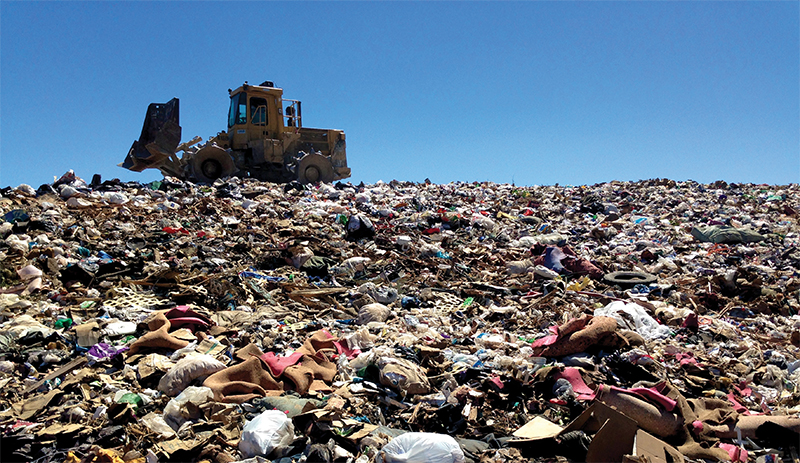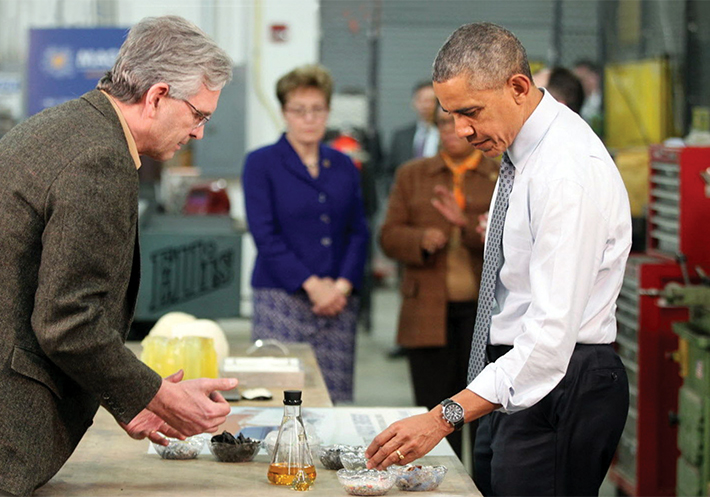
Recycling Technology Converts Plastic Waste to Energy
NASA Technology
Glenn Research Center has always been in the business of perfecting engines. During World War II, the center, then called the Aircraft Engine Research Laboratory, developed a cooling system for the B-29 Super Fortress—a four-engine, propeller-driven heavy bomber that saw action in East Asia—and also investigated carburetor icing issues in preparation for aircraft flying over the Himalayas into China. In 1945, well before the dawn of the Space Age, trailblazing rocket scientists there began investigating the use of liquid hydrogen as a fuel source, culminating in the development of the Centaur rocket, which would become the Nation’s first upper-stage launch vehicle. Since the mid-1960s, Centaur has propelled into space numerous weather probes, communications satellites, and planetary explorers, such as Surveyor, Pioneer, Viking, and Voyager.
While Glenn has continued to flex its rocket-science muscles by improving ion propulsion technology for deep space missions and helping to mature additive manufacturing for rocket engines, the center has also shown its versatility by helping one Cleveland company improve, of all things, an innovative plastics recycling technology.
Technology Transfer
As good as it feels to throw plastic items into the recycling bin, the fact is most of that plastic goes unrecycled, according to Jim Garrett, a veteran of the oil and gas industry. “Of all the stuff my wife makes me sort on a weekly basis, most of it ends up in a landfill,” he says. “It’s a dirty little secret in America that 90 percent of our plastic ends up there, if not in our oceans.”
The reason for the low rate of recycling is that many plastics contain additives and fillers that make them incompatible with current recycling technologies, while others are contaminated with paper or ink. “Recycling companies take in the clear water bottles, but most of the other stuff is not recycled,” Garrett says. But as the old adage goes, one man’s trash is another man’s treasure. In 2009 Garrett met petroleum geologist and geochemist Bill Ullom, who had in mind a technology that could make use of all this unwanted plastic in order to strike oil, or at least manufacture it.
In 2005 Ullom happened on an expired patent for a thermal depolymerization process that could convert plastic back into its original form: light crude oil. The technology works by sending plastic feedstocks, as well as tires and car interiors, through a shredder, where rotating cutters shred the material before sending it through an extruder/kiln combination, where the feedstock is incrementally heated, producing vapor. At the exit of the process path, the vapor is released and condensed into liquid form and distilled into derivatives of light crude oil, namely fuel gas and diesel additive. The last and only solid byproduct of the process is inert char, which can serve as a strengthening agent in rubber products, among other uses.
Ullom began making improvements to the process that allowed the technology both to run nonstop and to accept contamination from materials such as wood and cardboard. After meeting Garrett, who had the business acumen to get the idea off the ground with investors, he founded Cleveland-based Vadxx Energy LLC and became its chief technology officer, with Garrett filling the role of CEO.
Things moved quickly from there, as the fledgling company initiated public-private partnerships with city and state agencies to receive technical guidance and acquire low-interest loans. Fortune 500 company Rockwell Automation also lent both its technical and plant construction expertise to Vadxx, and the nonprofit Manufacturing Advocacy and Growth Network, or MAGNET, also provided logistical and technical support.
Even so, by 2012 the company still needed help optimizing the kiln’s design, which, according to Stan Prybyla, Vadxx’s vice president of technology, would be a complex task. “A proper solution to the problem would have to involve the kiln’s geometry, tilt angle, and rotation speed, along with the polymer’s thermodynamic and physical properties, during standard processing timescales,” he says. “The problem was quite challenging, to say the least.” Yet that’s the type of work that falls right in Glenn’s wheelhouse.
While one wouldn’t necessarily think NASA has much in common with a trash-recycling technology, Paul Bartolotta, a senior technologist at Glenn, says the Agency’s work on rocket propulsion makes it especially adept at analyzing such a process. “We have scientists who for decades have been studying the kinematics of oil decomposition for turbine engines and kerosene rocket engines,” he says. “It’s still looking at oil—it’s just that, in this case, we’re extracting it out of waste plastics.”
Glenn’s collaboration with Vadxx was made possible through Cleveland and the greater Cuyahoga County’s Adopt a City Program, itself a product of the Obama Administration’s Strong Cities, Strong Communities Initiative, whereby Federal agencies are asked to team up with local governments to provide technical assistance and other expertise to area businesses. Bartolotta, who wears many hats at Glenn, managed the program on NASA’s end.
In May 2012, Vadxx was one of eight companies that qualified for the program (another being Pile Dynamics Inc., featured on page 80), which came with 40 hours of pro bono consultation. As a result, within the span of a few weeks, a team of four scientists from Glenn’s chemistry kinematics group “created a kinematic model where Vadxx could put in the diameter of the kiln, the feed rates, and the viscosity of the polymers, and it’ll optimize the process,” Bartolotta says. “They’d be able to maximize the output of the oil byproduct.”
The model proved to be a success, says Prybyla. “We were able to incorporate what we learned into the making of our first full-scale commercial kiln.”
Benefits
With a cash infusion from Liberation Capital, Vadxx is building that kiln in nearby Akron, with Rockwell Automation leading construction and engineering efforts. When fully operational, it will be able to process some 20,000 tons of waste per year to produce 100,000 barrels of petroleum product that will be sold to distributors and marketers. While Vadxx will operate that facility, its expansion plans center around licensing the technology to other entities. The company estimates there’s enough feedstock in the United States to build 1,500 Vadxx units, which would decrease the Nation’s oil imports by 7 percent.
And all those units would be environmentally friendly, according to Garrett. No hazardous byproducts are created, and, unlike most companies that flare off excess fuel gas, which contributes to global warming, Vadxx recycles that gas to provide 80 percent of a unit’s heating needs. “From both an economic and environmental standpoint, it’s a winner,” he says. “The EPA [Environmental Protection Agency] classifies our unit as only a minor emitter, equivalent to a hospital boiler. And the key there is we’re not burning feedstock but melting it in a vessel. It’s not like we’re building a new refinery where it takes 10 years to get the approval.”
The future looks auspicious for the company, as the technology has generated enormous interest from waste disposal companies and large manufacturing facilities, which stand to gain by paying less money to truck material to a Vadxx unit than to the landfill. What’s more, each unit is projected to make $8 to $12 million per year in revenue for its operator and provide 18 full-time jobs.
Besides the technical leg-up NASA gave the company, Garrett says there was another, more indirect benefit of having partnered with the Agency: credibility. “We’d kind of brag to people that we worked with NASA, and they say, ‘Really? I may be interested in investing.’ The NASA name has that kind of impact.”

Vadxx president Jim Garrett speaks with President Barack Obama about the company’s plastics recycling technology at the Manufacturing Advocacy and Growth Network, or MAGNET, Innovation Center in Cleveland. The president visited the town on March 18, 2015, to learn how businesses were benefiting from working with MAGNET, which helped Vadxx connect with NASA Glenn Research Center through the Adopt a City Program, itself a byproduct of the Obama administration’s Strong Cities, Strong Communities Initiative.

A landfill located in Buckhorn Mesa, Arizona. According to the Environmental Protection Agency, only 9 percent of plastic waste generated in 2012 was recovered for recycling. According to Jim Garrett, president of Vadxx Energy LLC, a major reason for the low number is that many plastics either contain additives and fillers that make them incompatible with current recycling technologies or are contaminated with paper or ink. The company’s recycling technology overcomes those limitations as it converts many types of plastic into light crude oil. Image courtesy of Adam Levine, CC BY 2.0













